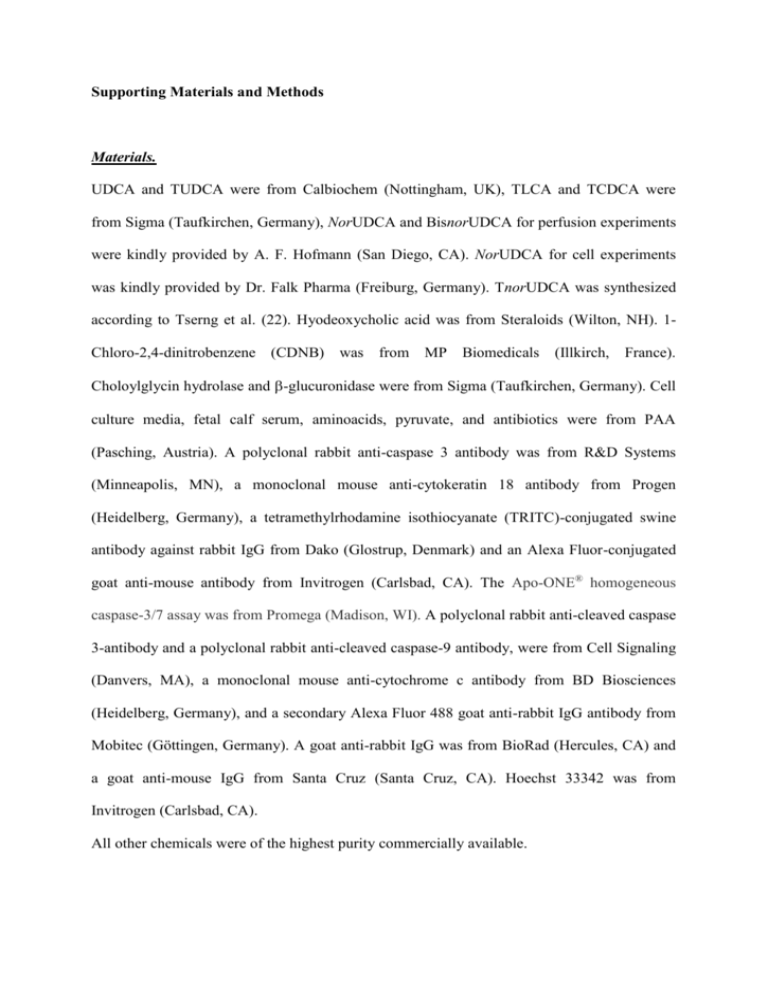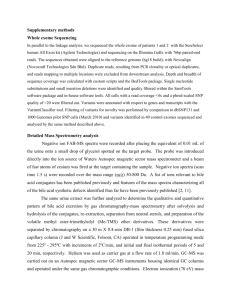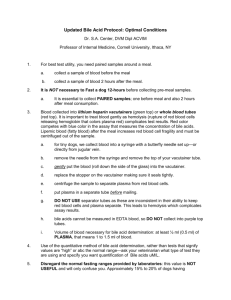HEP_23911_sm_suppinfo
advertisement

Supporting Materials and Methods Materials. UDCA and TUDCA were from Calbiochem (Nottingham, UK), TLCA and TCDCA were from Sigma (Taufkirchen, Germany), NorUDCA and BisnorUDCA for perfusion experiments were kindly provided by A. F. Hofmann (San Diego, CA). NorUDCA for cell experiments was kindly provided by Dr. Falk Pharma (Freiburg, Germany). TnorUDCA was synthesized according to Tserng et al. (22). Hyodeoxycholic acid was from Steraloids (Wilton, NH). 1Chloro-2,4-dinitrobenzene (CDNB) was from MP Biomedicals (Illkirch, France). Choloylglycin hydrolase and -glucuronidase were from Sigma (Taufkirchen, Germany). Cell culture media, fetal calf serum, aminoacids, pyruvate, and antibiotics were from PAA (Pasching, Austria). A polyclonal rabbit anti-caspase 3 antibody was from R&D Systems (Minneapolis, MN), a monoclonal mouse anti-cytokeratin 18 antibody from Progen (Heidelberg, Germany), a tetramethylrhodamine isothiocyanate (TRITC)-conjugated swine antibody against rabbit IgG from Dako (Glostrup, Denmark) and an Alexa Fluor-conjugated goat anti-mouse antibody from Invitrogen (Carlsbad, CA). The Apo-ONE® homogeneous caspase-3/7 assay was from Promega (Madison, WI). A polyclonal rabbit anti-cleaved caspase 3-antibody and a polyclonal rabbit anti-cleaved caspase-9 antibody, were from Cell Signaling (Danvers, MA), a monoclonal mouse anti-cytochrome c antibody from BD Biosciences (Heidelberg, Germany), and a secondary Alexa Fluor 488 goat anti-rabbit IgG antibody from Mobitec (Göttingen, Germany). A goat anti-rabbit IgG was from BioRad (Hercules, CA) and a goat anti-mouse IgG from Santa Cruz (Santa Cruz, CA). Hoechst 33342 was from Invitrogen (Carlsbad, CA). All other chemicals were of the highest purity commercially available. Methods. Quantification of bile acid levels in bile, liver tissue, and hepatovenous effluate by capillary gas chromatography. Liver tissue was homogenized by sonication with a Branson sonifier B-12 (Branson, Danburn, CT) in 0.1 mol/L NaOH and lysed at 80 °C for 20 minutes. Bile acids were extracted from the hepatovenous effluate and liver tissue lysate by a solid phase extraction technique with Bond Elut-C18 extraction columns (Varian, Darmstadt, Germany) similar as described earlier (25, 26). Bile acids from bile were determined after extraction of lipids with n-hexane. Bile acids were deconjugated by enzymatic hydrolysis with choloylglycin hydrolase and by glucuronidase (only for liver tissue), isolated by adsorption to Lipidex-1000 columns (Packard Instrument, Groningen, The Netherlands). Bile acids were then eluted with methanol (75% v/v) and methylated and converted to their trimethylsilyl derivatives. Hyodeoxycholic acid (5-cholanic acid-3,6-diol) was used as internal standard for quantification of bile acids (26). Bile acid analysis was performed by a Carlo Erba HRGC 5160 gas chromatograph (Carlo Erba, Hofheim, Germany). Bile acids were separated by a 25 m CP Sil 19 CB capillary column (Varian) with hydrogen being the carrier gas at a pressure of 65 mbar. Eluted bile acid derivates were detected by a flame ionisation detector FID-40 (Carlo Erba). Peaks of bile acids were identified by their retention times as compared to those of known standards (purchased from Steraloids, Newport, RI). Hepatobiliary anion secretion. Biliary secretion of the Mrp2 substrate, GS-DNP, was determined spectrofluorometrically as described earlier (13, 14). After adding 5 µL of bile to 1 mL of water, absorption was measured at 335 nm wavelength in a cuvette. The biliary GS-DNP concentration [nmol/L] was calculated using the formula c = E335 * Vtotal/( * d * Vbile); E335, absorption at 335 nm; Vtotal, 1005 μL; molar absorption coefficient, 9.6 L/(mmol * cm); d, 1 cm; Vbile, 5 μL. The low background absorption of the bile sample collected before application of CDNB was set as 0. Immunocytochemical quantification of apoptosis in Ntcp-transfected HepG2 hepatoblastoma cells. Human HepG2 hepatoblastoma cells were stably transfected with a pcDNA3.1/Na+taurocholate cotransporting polypeptide (Ntcp) construct (Ntcp-HepG2 cells) as described previously (30), were grown in MEM (pH 7.4, 37 °C, 5% CO2) containing 10% fetal bovine serum, 1% non-essential amino acids, 2 mmol/L L-glutamine, 1 mmol/L sodium pyruvate, 100 U/mL penicillin, 100 µg/mL streptomycin, and 0.25 µg/mL amphotericin B, and were incubated in MEM with bile acids or DMSO (0.025%, v/v; control) for 4 hrs. Then, the supernatant was carefully removed, and cells were fixed with a fixation buffer containing 3% formaldehyde. After fixation, Ntcp-HepG2 cells were incubated at a concentration of 1:100 for 24 hours at 4 °C with an anti-cleaved caspase 3-antibody for quantification of apoptosis. Subsequently, cells were incubated with a secondary anti-rabbit IgG antibody at a concentration of 1:200 for 1 hour at room temperature. Nuclear DNA fragmentation was disclosed with Hoechst 33342. The studies were conducted on a Zeiss Axiovert 135TV microscope with the AxioCam MRm and imaging software AxioVision 3.1. Living and dead cells were counted by two examiners independently and results were expressed as percentage of total cells. Quantification of apoptosis in Ntcp-transfected HepG2 hepatoblastoma cells by immunoblotting and fluorescence techniques. Ntcp-transfected HepG2 cells were cultured as described above and exposed to bile acids (100 µmol/L GCDCA, TnorUDCA, TUDCA, and TCDCA, each; 50 µmol/L TLCA) for 1 hour (for determination of cleaved caspases 3 and 9 and cytochrome c) or for 4 hours (for determination of caspase 3/7 activities). Cleaved caspases 3 and 9 were quantified from whole cell lysates. Cytochrome c was determined in cytosolic fractions. Immunoblotting was performed by a standard technique as described previously (31) with 12.5% SDS-PAGE using a polyclonal rabbit anti-cleaved caspase-3 antibody (1:1000), a polyclonal rabbit anti-cleaved caspase-9 antibody (1:1000), and a monoclonal mouse anti-cytochrome c antibody (1:2000). For detection of primary rabbit antibodies, a goat anti-rabbit IgG and of primary mouse antibodies a goat anti-mouse IgG were used. Specific bands were quantified densitometrically with a chemiluminescence technique and TINA 2.0 software (Raytest, Straubenhardt, Germany). For determination of the activities of caspase 3/7 in HepG2 hepatoma cells, the Apo-ONE® homogeneous caspase-3/7 assay from Promega was used according to the manufacturer’s instructions.








